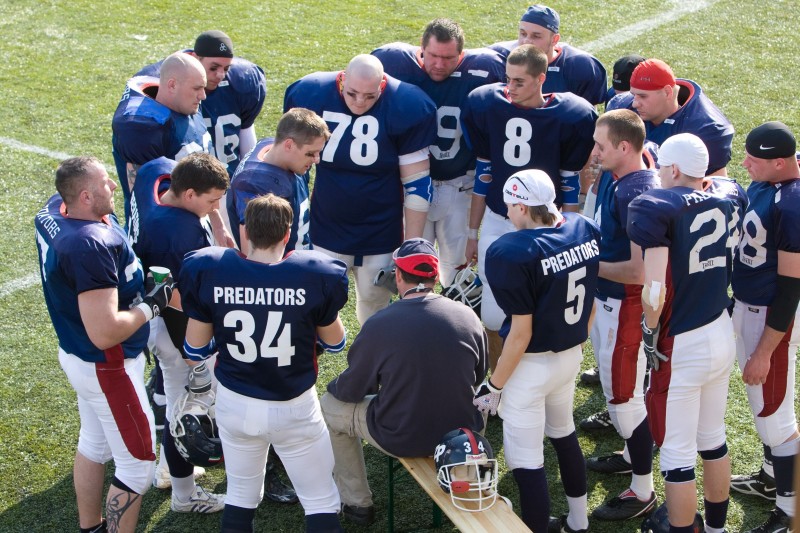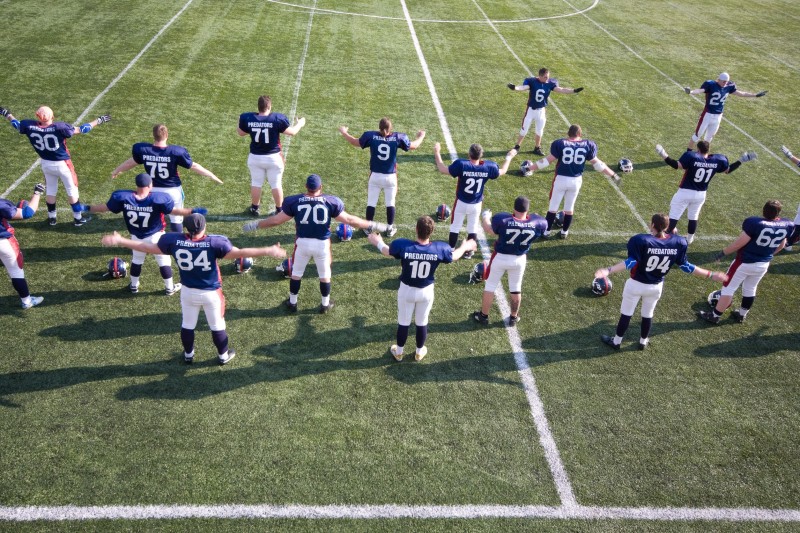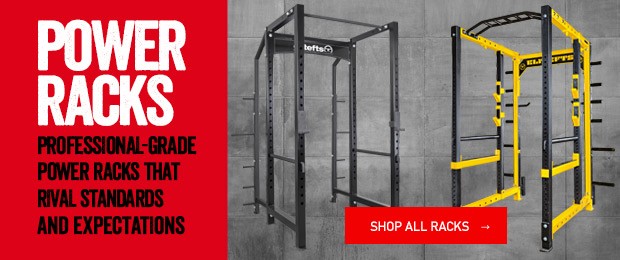
The profession of strength and conditioning is at a critical juncture right now. We are all under attack. We better do something about it, and do it right. If things keep progressing in the matter they are now, we will have to answer to people who have absolutely no practical knowledge of what we do and what it really takes to do it. It will be a recipe for disaster, and if we don’t get it under control, it will be the end of our profession as we know it. Some of this we have brought on ourselves, but the rest is beyond our control.
The steps leading us to this place and time started out as vertical, then went horizontal, and is now in complete discord. The pioneers of strength and conditioning were a bunch of guys who thought it was pretty cool to help athletes get stronger and faster. There were not many of them, and if you took all the knowledge you're able to download in five minutes today, you will have the information equivalent to what it would have taken them five years to learn. What did they do to get better? They experimented, studied their craft, and learned from each other. It did not matter what school you were at, big or small. If you needed info there was always someone willing to lend a helping hand.
I had an excellent strength coach when I was younger. He could get anyone stronger but had no idea about speed development or conditioning. When I got a job working at a high school, I reached out to Brad Roll when he was at the University of Miami winning national championships. He did not know me from a hole in the wall, but he sent me their entire summer workout packet. The run progressions and programming were as incredible then as they are now, and I still use them today. I am still indebted to a man I have never met, and I cannot thank him enough. Remember, those were the days of actually mailing a letter and some cash to cover the postage — no click and paste. He had to go out of his way to mail it to me. Strength coaches looking out for strength coaches.

The profession grew and strength coaches started getting smarter, combining science with the real world knowledge that they gained from personal experience and athlete/team experimentation. They started building their foundations on rock, providing athletes with scientifically-proven workout programs and adding their own real-world experiences. They were all under one voice and basically started the NSCA to exchange ideas and network with each other. They started this whole thing as a brotherhood. They all lifted in one of the disciplines (Olympic lifting, powerlifting and bodybuilding) and one (John Gamble) competed in the finals of World’s Strongest Man. They met before and after games and learned from each other in the off-season. Sport coaches started to see the benefits that strength training could bring to their teams and jobs started to appear. The profession was on a definite vertical track, and the future was bright.
Then Al Gore had to invent the Internet. People became geniuses overnight. Here was a place you get all this information in the comfort of your own home. People started to think, "if so-and-so said this" and "this guy isn't doing that" and "how did he get that job?" and "I could do that." People started undercutting others to try to get that $20,000 job. Practical knowledge and personal/team experimentation went out the window – why would you have to get under the bar when the Internet can tell you the same thing?
So the profession started to even out, moving in a horizontal plane with everyone jockeying for position, fighting for a seat at the table. Once things settled down, we were ready to move vertically again. Then the money came. Football coaches started making crazy amounts of money and all the good stuff to go with it. They became paranoid and had to have everything and everyone they wanted to work with them. Everyone needed “their” guy. For a lot of us it was great for a while: the team won and everybody moved up. Strength coaches started getting paid what they were worth and became integral parts of staff teams.
Information was flowing freely, but we started losing touch with each other. Staff members started to not worry about where they were, but which coach was going to be head guy somewhere and if he would take them with him. The Collegiate Strength and Conditioning Association was formed, so now we had two federations trying to guide aspiring coaches. Certified or not, it didn't matter; if the millionaire coaches wanted you, they got you. College football became so big, powerful, and unchecked that the NCAA felt they needed to put their foot down. So they had to find the weakest link in the college football chain – and they found it with us.
A house divided cannot stand. We were unregulated, had no clear decisive path, and lacked a clear voice speaking for the entire group, so guess what happened? Under the guise of athlete safety, their first experimental shot at us was to restrict the time we had in the off-season to work with these athletes. "For player safety," they said. So making them stronger and faster does not make them safer? Being in better shape does not help you perform in a more efficient manner, reducing your risk of injury? No. It was done to see if they could make a stand on something and get away with it — and they did.
Next shot: protein debacle. Yes to bagels, no to peanut butter. And they got away with it. There was no one to put a stop to it. Both federations were fighting each other and we were caught in the middle. Then came the classic: five strength coaches to work with football. Five. Again, player safety? We have the same number of athletes as the coaches do, ballpark 100. They have nine coaches, countless graduate assistants, interns, volunteers, and analysts to help them run practice. A conservative estimate is around 20 people — 40 eyes to 10. Safer? We lost that battle.
RELATED: Grading Professionalism in Collegiate Strength and Conditioning
They count all of those as little “victories” toward the establishment of college football and essentially leave the rest of it alone. Now we face the biggest battle: the battle of certification. This is the one we have to win, and we have to stop shooting ourselves in the foot when it comes to this. I know tragic things happen (usually during pre-season) and no matter what, we are to blame. It does not matter that a kid has an undiagnosed heart condition, which is the cause of so many of these terrible deaths. Why doesn’t the NCAA require mandatory testing for the heart abnormality that has killed probably 90% of these athletes in the past 10 years? Was there not a trainer present? Why are they not blamed for not pulling the player out if they thought they were in harm’s way? And when are we going to learn not to treat freshmen like upperclassmen in terms of lifting and running? What about how to train the team when they are back from a long layoff? What if a player is out drinking, dehydrates during a workout, and something happens? Our fault? All these things combined to form the perfect storm we are in now, with the wrong people asking the wrong questions and getting a hundred wrong answers.
This is real stuff that is happening right now — not just my opinion, but what is really going on. I am not bitching, but I am calling for change in the right way. My opinions on what I would like to see happen are as follows. You may not like them or agree, but I feel these things need to happen for us to get on a vertical path.
- We must take responsibility. We must do everything in our power to provide safe, effective training protocols that will increase performance and decrease the chance of injury.
- Learn from the trainers. Every trainer has to be certified by the National Athletic Trainers Association. It cannot be this federation or that federation, but one single governing body that gives them one voice. I am not saying that becoming certified makes you a better strength coach, but being uncertified does not make you a better one either. Why do you think they have so much job security? You cannot quantify what makes one trainer better than another trainer, and it is the same for us.
- NSCA and CSCCa must join forces. They need to join sooner rather than later. The CSCCa should be the collegiate arm of the NSCA. Grandfather all the college strength coaches that are NSCA certified to the CSCCa. The NSCA should also have a professional and high school division. This way we will have one voice, with more money and support than ever. Then tell the NCAA this is the one and only certification that colleges can go by, and that is the end of that. With all of us on the same page, we will not lose.
- Get our act together. Start realizing that there are a thousand ways to skin a cat, and everything you learn is a tool for your toolbox. Stop talking trash about the guy who was there before you. I hear from strength coaches all the time, “Man, when I took over this team they were the most out of shape, weak people I have ever seen.” You probably got the job because someone was fired after a bad season and most of the athletes had not touched a weight in two months. How strong would you be after two months off?
These are just a few things that I hope will start to spark some dialogue and get us all on the same page so we can move forward. This is a noble profession in many ways, even if you just count the people we get to impact on a daily basis. It is amazing how we can all blend a team with kids from different races, backgrounds, and financial means, but can’t name three strength coaches in our own conference. We know how to bring people together, and now is the time we just have to do it. This is not the time to be selfish and just worry about yourself. We need to focus on all of us as a whole. I am willing to help out in any way I can; I do not want to lose what has given me and countless others a job that we love. We cannot let them take it away from us. Too many people have sacrificed a lot more than you will ever know to make this profession what it is today. We must join forces now before it is too late.
Images courtesy of Csak Istvan © 123RF.com












4 Comments